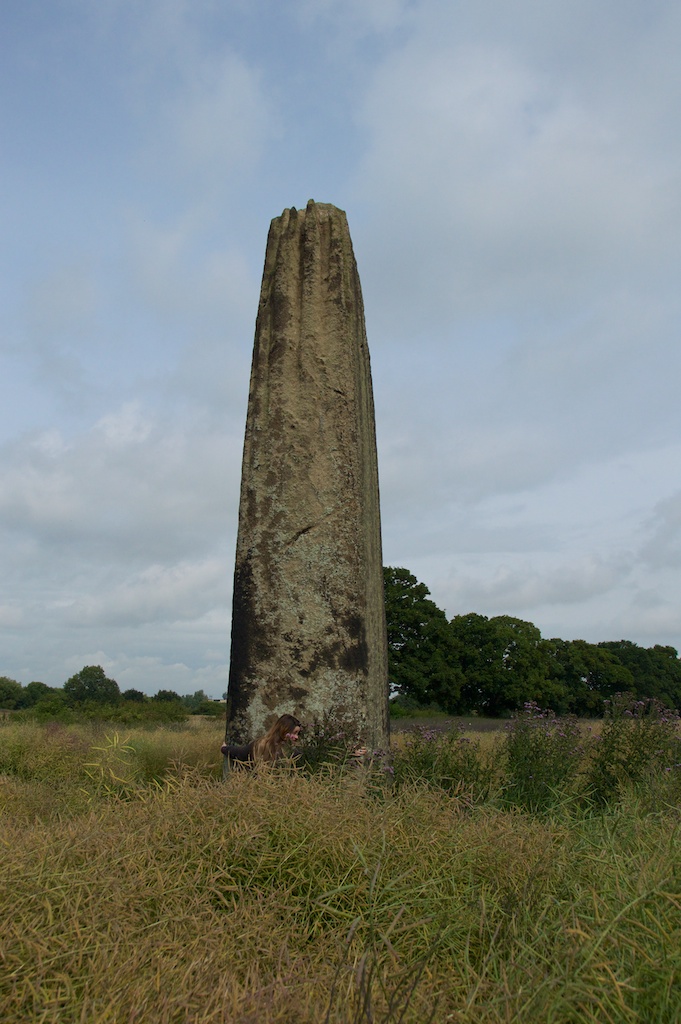
The Devil’s Arrows: shafts of darkness
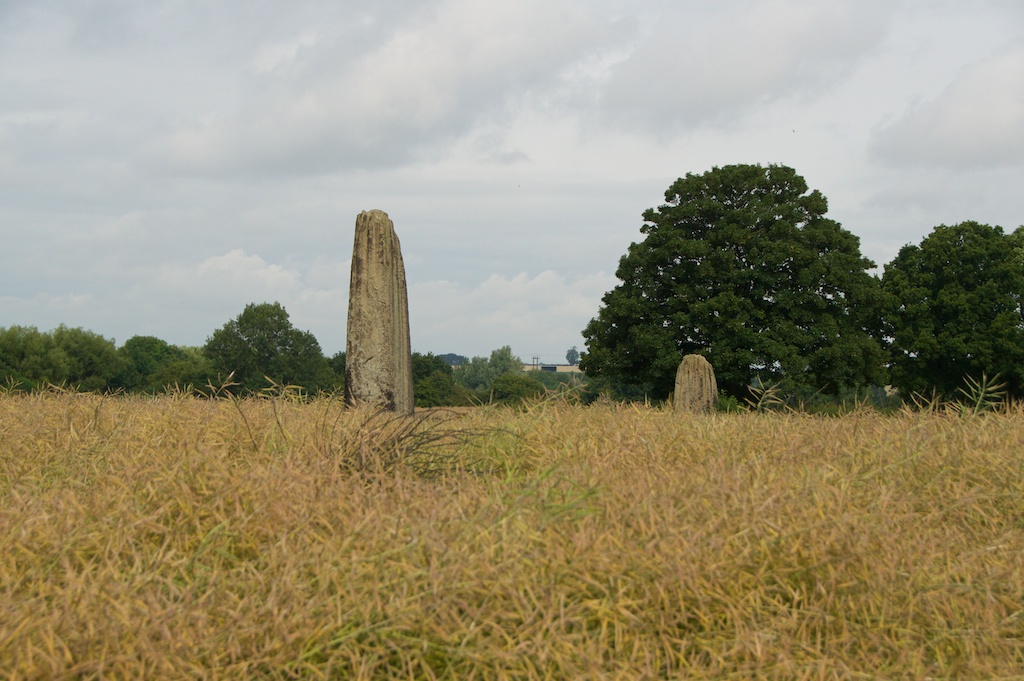 When we were in Yorkshire in early August, one of the things I most wanted to see was a row of three standing stones known as the Devil’s Arrows.
When we were in Yorkshire in early August, one of the things I most wanted to see was a row of three standing stones known as the Devil’s Arrows.
I’d seen photos of them and thought I might be impressed by their size. I certainly wasn’t wrong.
“This is the greatest single stone-row anywhere in the British Isles.”
The Devil’s Arrows can be found near Boroughbridge, very close to the busy A1M and the A168 that runs parallel to it. I’m sure you can hear the noise of the traffic, but by the time I’d caught sight of the stones I was so excited that I didn’t notice.
I went there with my daughter, Verity, and after finding somewhere to park the car – trickier than you’d think – our first excitement was stemmed slightly by the fact that the field in which two of the stones stand was shoulder-high in oilseed rape. Luckily, a path had already been made through the field by recent visitors.
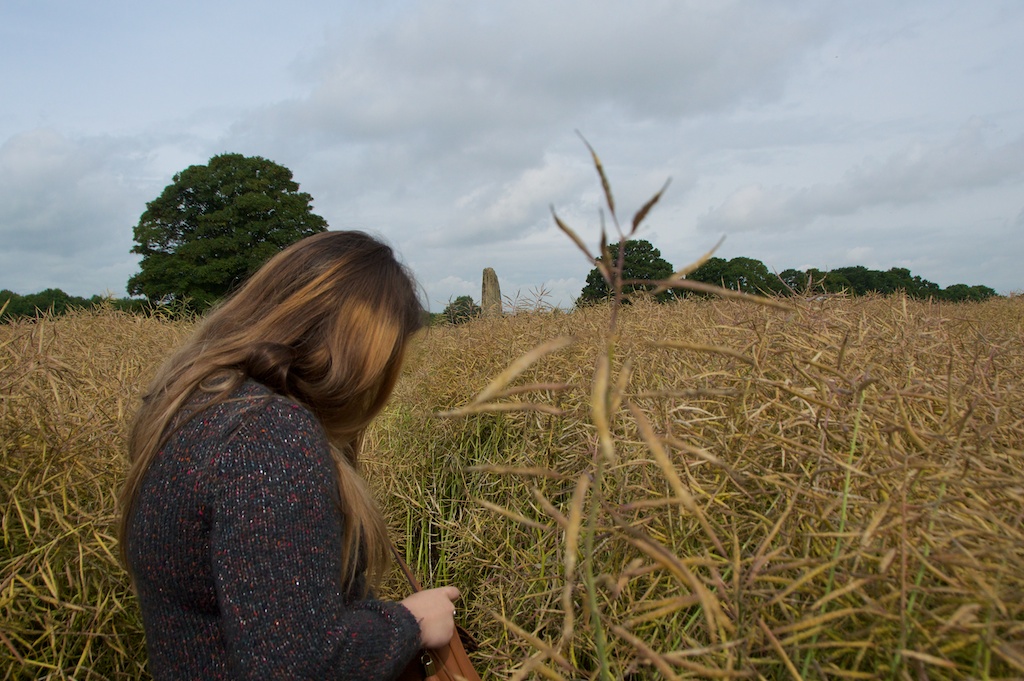 The middle stone, far from being engulfed, soared above the brown jungle like a Neolithic version of the Shard. We arrived at its base sporting a few new hair adornments and then walked all around it, gazing up in awe. The surface of the stone was rough, just as you’d expect of the gritstone from which they are hewn. A large area seemed to be plastered with a type of black lichen; and even more strikingly, deep vertical grooves had been worn – or carved – into its faces.
The middle stone, far from being engulfed, soared above the brown jungle like a Neolithic version of the Shard. We arrived at its base sporting a few new hair adornments and then walked all around it, gazing up in awe. The surface of the stone was rough, just as you’d expect of the gritstone from which they are hewn. A large area seemed to be plastered with a type of black lichen; and even more strikingly, deep vertical grooves had been worn – or carved – into its faces.

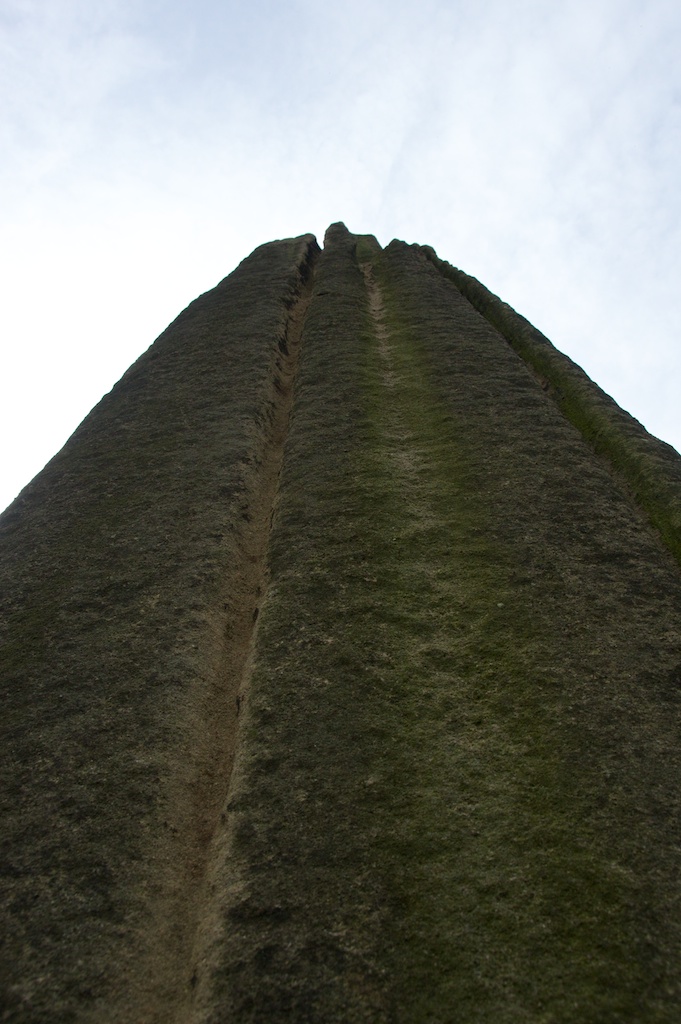
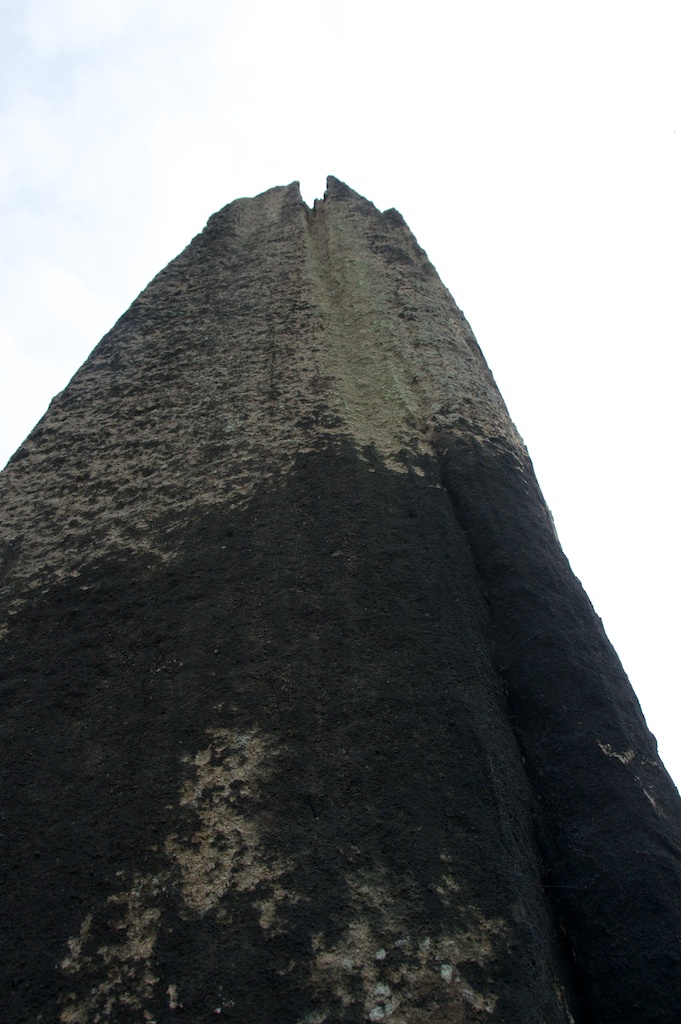
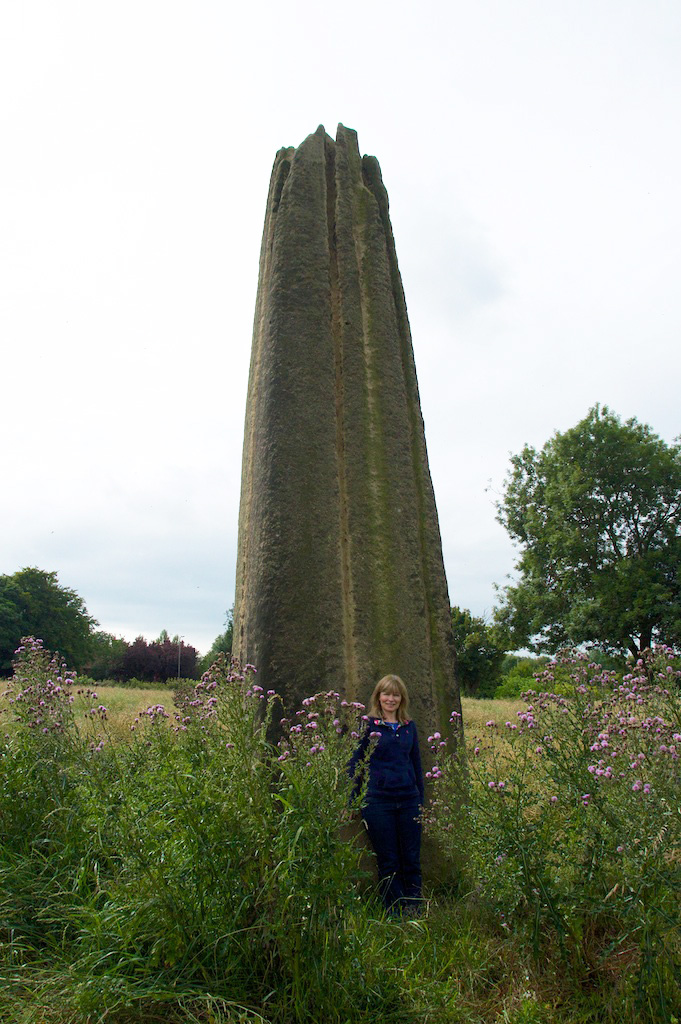 A little late, but better than never, I remembered that I’d brought my dowsing rods with me. Trust me to pick somewhere like this for their first solo outing! I could only take about three paces away from the stone before being swallowed by a forest of rapeseed. But I did find a strong spiralling effect by one corner of the monolith, which was confirmed by Verity, much to her delight; a blind spring, I wondered? When we looked down at the ground, it seemed that someone else had found it too, as a small piece of rock crystal had been placed on the exact spot.
A little late, but better than never, I remembered that I’d brought my dowsing rods with me. Trust me to pick somewhere like this for their first solo outing! I could only take about three paces away from the stone before being swallowed by a forest of rapeseed. But I did find a strong spiralling effect by one corner of the monolith, which was confirmed by Verity, much to her delight; a blind spring, I wondered? When we looked down at the ground, it seemed that someone else had found it too, as a small piece of rock crystal had been placed on the exact spot.
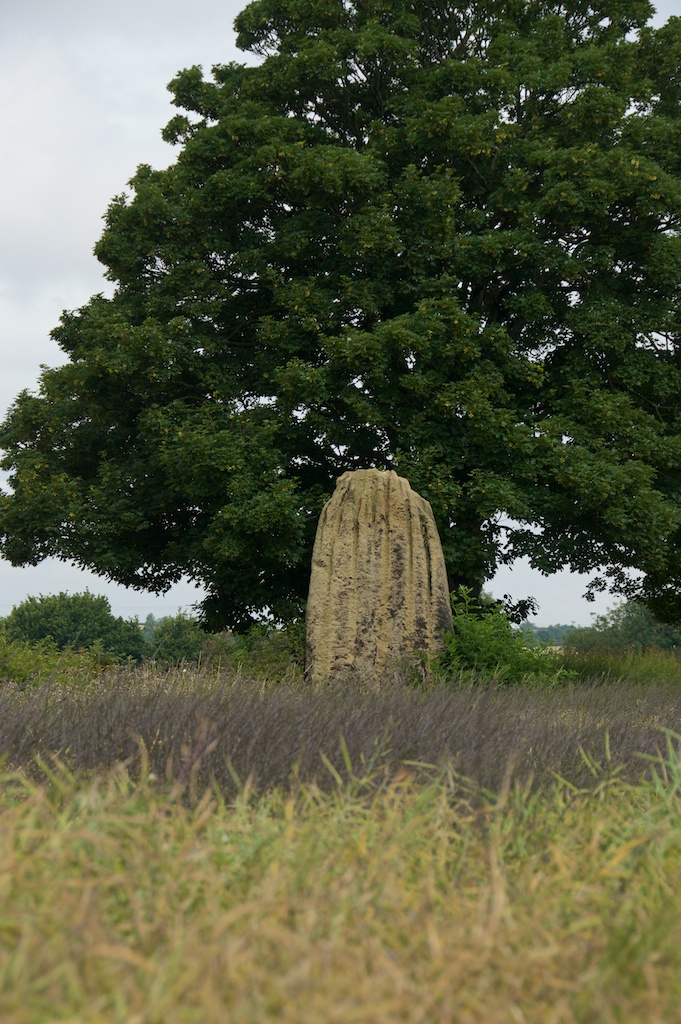 We decided to admire the furthest stone (above) from a distance, and turned our attention to the third and tallest member of the Arrows, which stands in a little wooded clearing by the side of Roecliffe Lane. In fact, it had been watching us all the time…
We decided to admire the furthest stone (above) from a distance, and turned our attention to the third and tallest member of the Arrows, which stands in a little wooded clearing by the side of Roecliffe Lane. In fact, it had been watching us all the time…
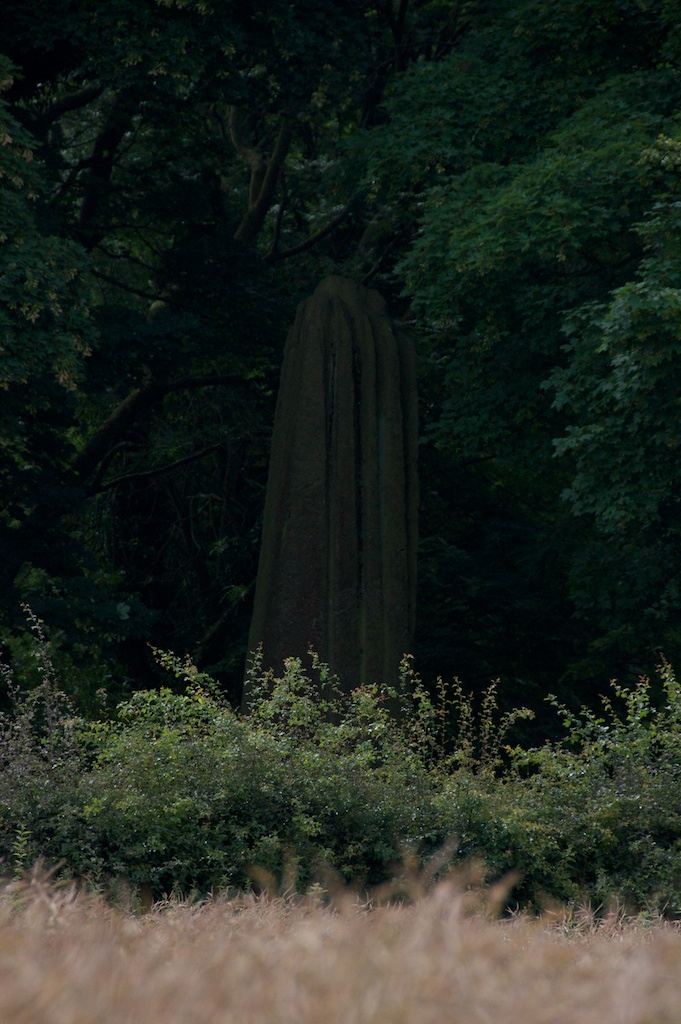 This one has its own fencing along the roadside and even a special sign with a blue plaque explaining its significance. I was put in mind of a dangerous animal in a zoo enclosure, and the huge dark presence of this stone didn’t do much to dispel that impression. The trees met above its head, but they seemed to be standing a good distance away from it. Again, there was the same mysterious grooving that is visible on all three of the Arrows, and the suggestion of cup-marks around the base. Weathering? I am not at all convinced.
This one has its own fencing along the roadside and even a special sign with a blue plaque explaining its significance. I was put in mind of a dangerous animal in a zoo enclosure, and the huge dark presence of this stone didn’t do much to dispel that impression. The trees met above its head, but they seemed to be standing a good distance away from it. Again, there was the same mysterious grooving that is visible on all three of the Arrows, and the suggestion of cup-marks around the base. Weathering? I am not at all convinced.
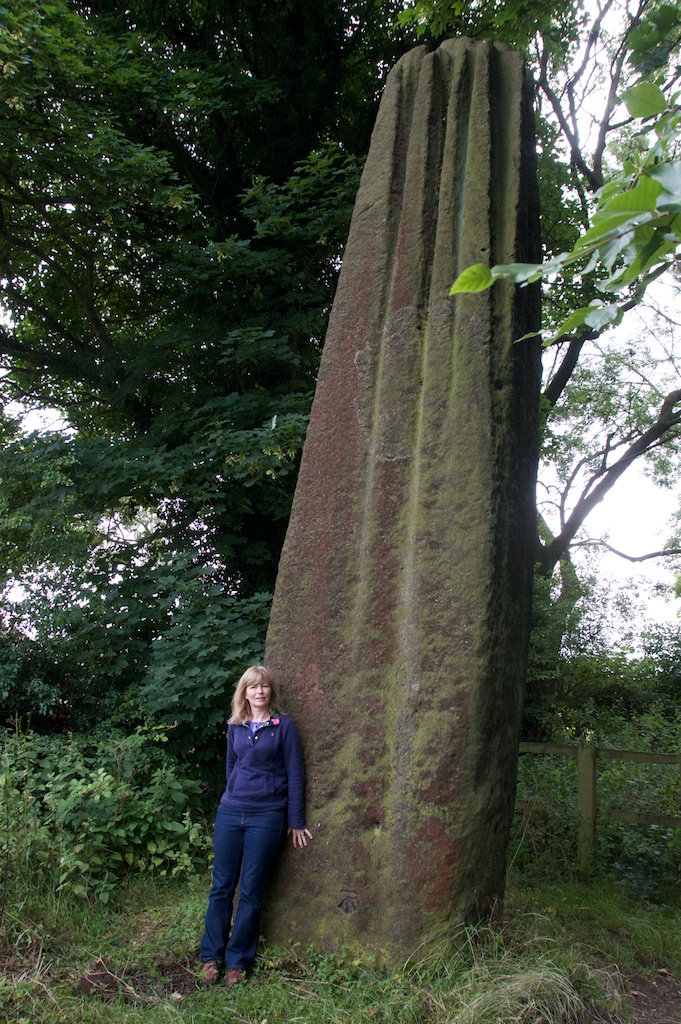 Verity hugged the stone and immediately felt light-headed, and I must admit that I had a similar sensation while standing next to it. As I posed for a photo, I must have leant a little too hard on the rods in my back pocket, because when I pulled them out I found that one of them had all but snapped in two. I’m thinking I should start a new blog, entitled ‘Disastrous Dowsing’.
Verity hugged the stone and immediately felt light-headed, and I must admit that I had a similar sensation while standing next to it. As I posed for a photo, I must have leant a little too hard on the rods in my back pocket, because when I pulled them out I found that one of them had all but snapped in two. I’m thinking I should start a new blog, entitled ‘Disastrous Dowsing’.
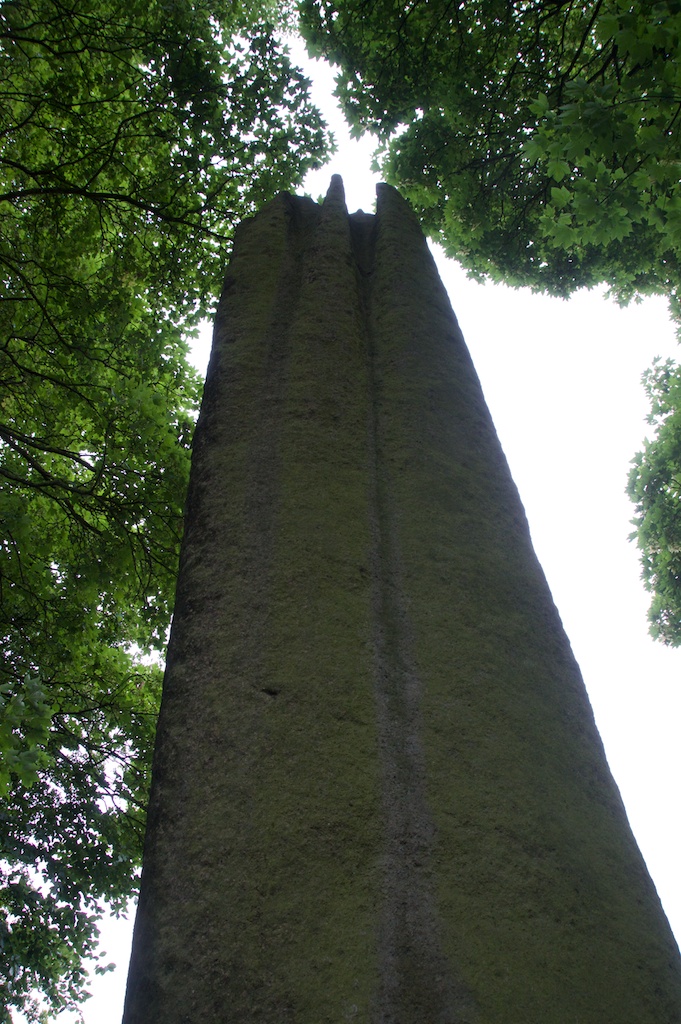
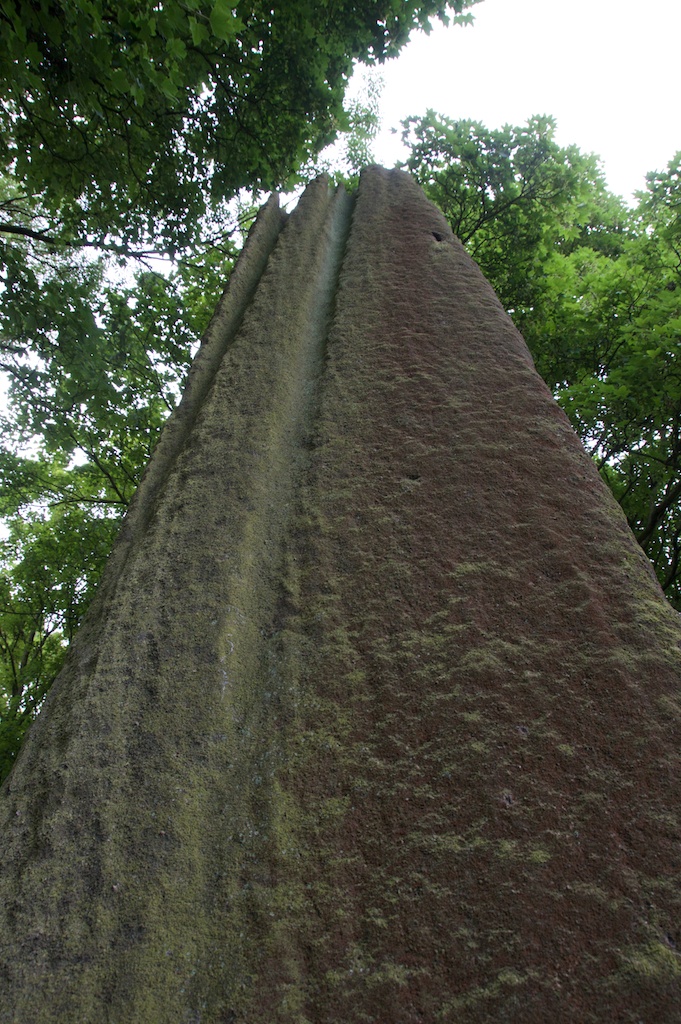
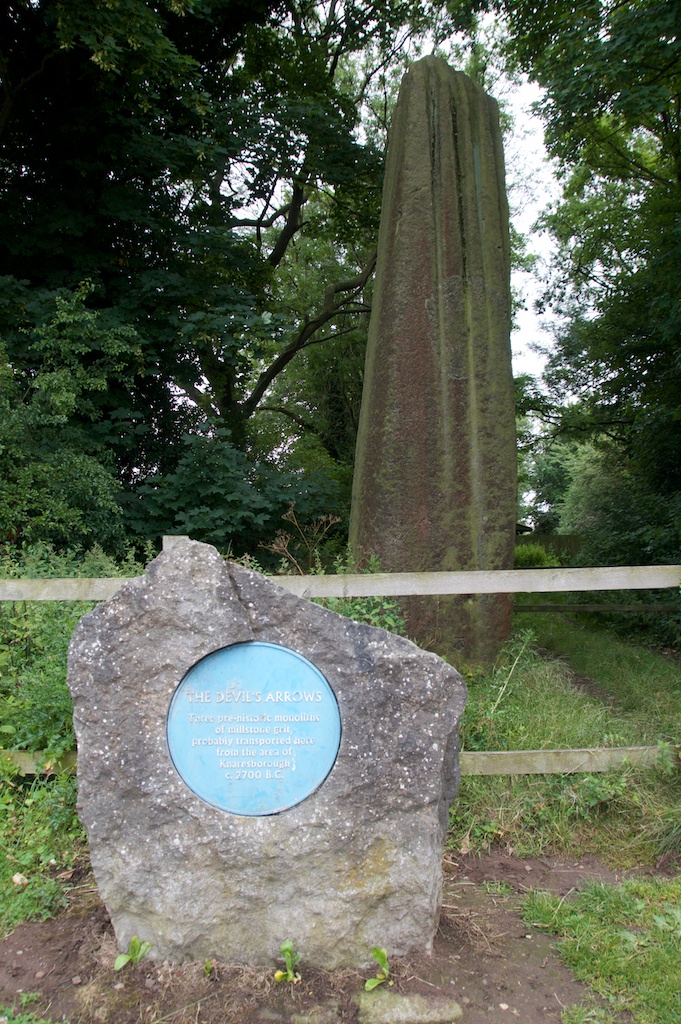 I was interested to see that another offering had been placed at the foot of the third stone – a little bunch of wheat, tied in a bundle.
I was interested to see that another offering had been placed at the foot of the third stone – a little bunch of wheat, tied in a bundle.
What’s with all those grooves?
The Devil’s Arrows are not by any means the only stones to be marked or shaped in this way. This is what Alfred Watkins has to say, describing the Queen Stone near Symond’s Yat in his book, ‘The Old Straight Track’:
“Most inexplicable of all the mark stones are those with clean-cut grooves running from the top to the bottom of an upright or ‘long’ stone. The Queen Stone in the horseshoe bend of the Wye near Symond’s Yat is a fine Herefordshire example… The grooves die out before reaching the ground but continue in an irregular way over the apex… it seems quite impossible that they should result from any natural cause….
The top of the stone is irregularly corroded, and the probability of this being caused by fire presents itself. I tried the insertion of broomsticks in these grooves but the tops projecting on opposite sides were too irregular for such a method to have been used for sighting.”
I can just imagine Alfred Watkins putting broomsticks in the grooves. About the Devil’s Arrows, he wrote: “These three are 16½ to 22½ feet high, in a direct line north and south, from 200 to 300 feet apart. Their alignment (there were four aligning in Leland’s time) indicates that they are on a ley.” He was slightly incorrect about their placing, because they are not set in a precisely straight line – the middle stone is offset a little to the west. But the height is accurate, making the tallest one higher than Stonehenge.
And were there originally more than three? It seems as if there were – but just how many we’ll never know. According to the antiquarian William Stukeley, there were five stones here in the early 18th century, and 1694 a fisherman named Peter Franck reported seeing seven of them. John Leland saw four stones in the 1530s, but in 1592 William Camden visited Boroughbridge and was horrified to discover that one of them had been uprooted. The lower half of this stone was apparently used as a bridge over the River Tut, while the top portion was said to be preserved in the grounds of Aldborough Manor; smaller fragments were rumoured to grace local gardens.
“…foure huge stones, of pyramidal forme, but very rudely wrought, set as it were in a straight and direct line… whereof one was lately pulled downe by some that hoped, though in vaine, to find treasure.”
William Camden
The age of the stones is open to speculation, but the blue plaque on the roadside offers a date of 2700 BC. Each Arrow is said to weigh over 40 tons, and their height is even more amazing when you learn that another five feet or so lies below the surface.
“The first recorded excavation at the foot of the stones was in 1709 when a nine-foot area around the central stone was opened. This revealed that just below the topsoil, cobbles, grit and clay had been packed around the stone to a depth of five feet. The base of the stone had been dressed by pointed tools to produce a smooth bottom which sat squarely on the hard packed clay beneath.” Ancient Wisdom
The Arrows are believed to have been hewn from a rocky outcrop at Plumpton, south of Knaresborough. I haven’t visited Plumpton Rocks, but a little research shows that they bear very similar vertical grooves, parallel and close together. To me, and I am the first to admit that I am a mere bystander, this doesn’t look like the natural weathering of water on stone.
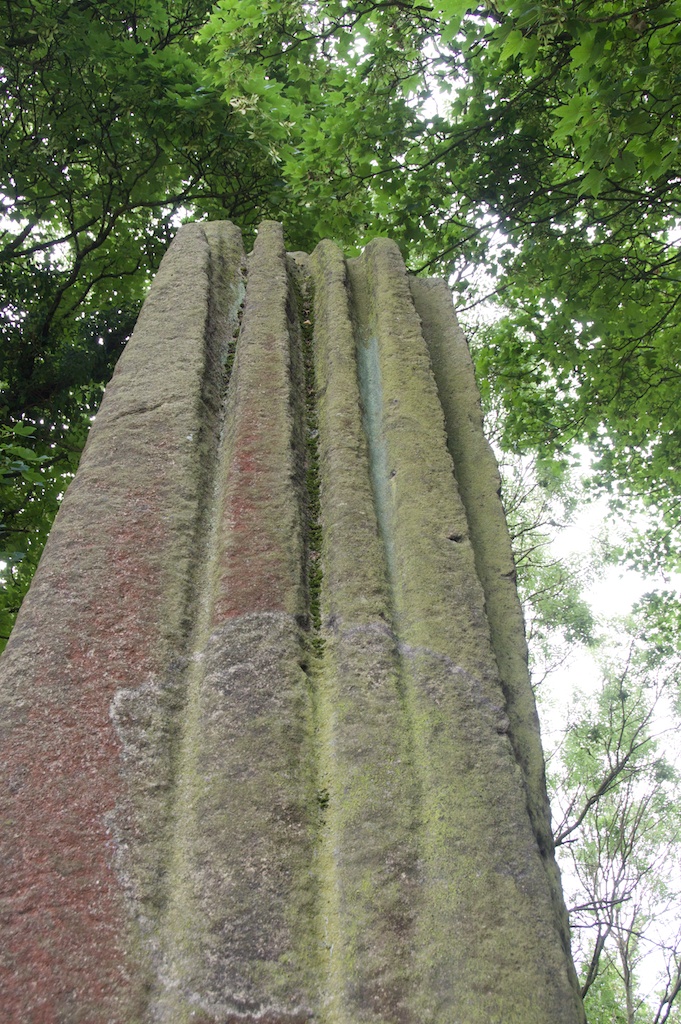 But then, of course, there’s another theory of how they got here…
But then, of course, there’s another theory of how they got here…
An old legend claims that the Devil stood on How Hill and prepared to fire three arrows at the village of Aldborough, whose residents had for some reason offended him. He shouted, “Borobrigg keep out o’way, for Aldboro town I will bring down.” But the arrows missed their target and landed in a field. This is a familiar theme with many heaps of stones around the British Isles, but I’ve got to say that these missiles were more dangerous than most! Just for good measure, a local superstition warns that walking 12 times around one of the stones in an anti-clockwise direction will summon the Devil.
This was a fun experience, and Verity and I are still pondering our impressions of these colossal stones. I have made a mental note to re-visit them in the winter time, when the fields are bare and their full height can be appreciated.
Further reading:
- Ancient Wisdom
- The Northern Antiquarian
- ‘The Old Straight Track‘ by Alfred Watkins
Photos copyright © Jo Woolf
Coming soon…
 I want to show you this photo, of one of the Tuilyies stones near Dunfermline. It bears similar grooved markings, although it is nowhere near as tall as the Devil’s Arrows. I’ll be writing about these soon on The Hazel Tree.
I want to show you this photo, of one of the Tuilyies stones near Dunfermline. It bears similar grooved markings, although it is nowhere near as tall as the Devil’s Arrows. I’ll be writing about these soon on The Hazel Tree.
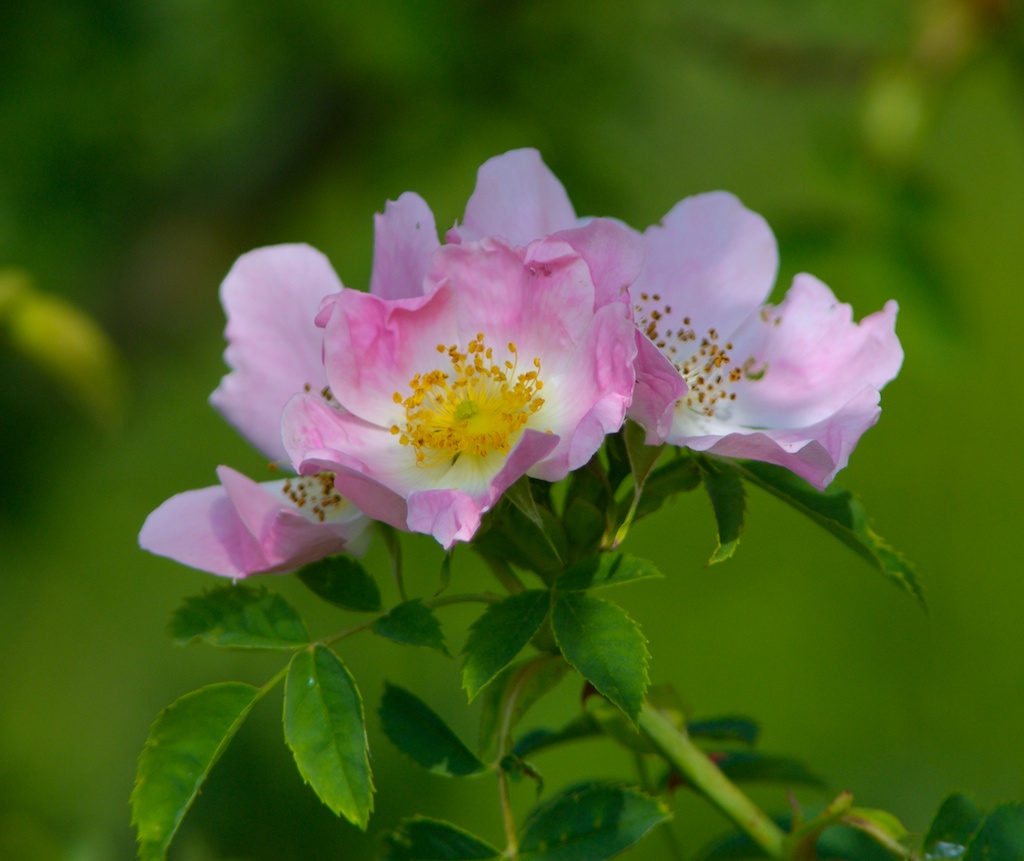
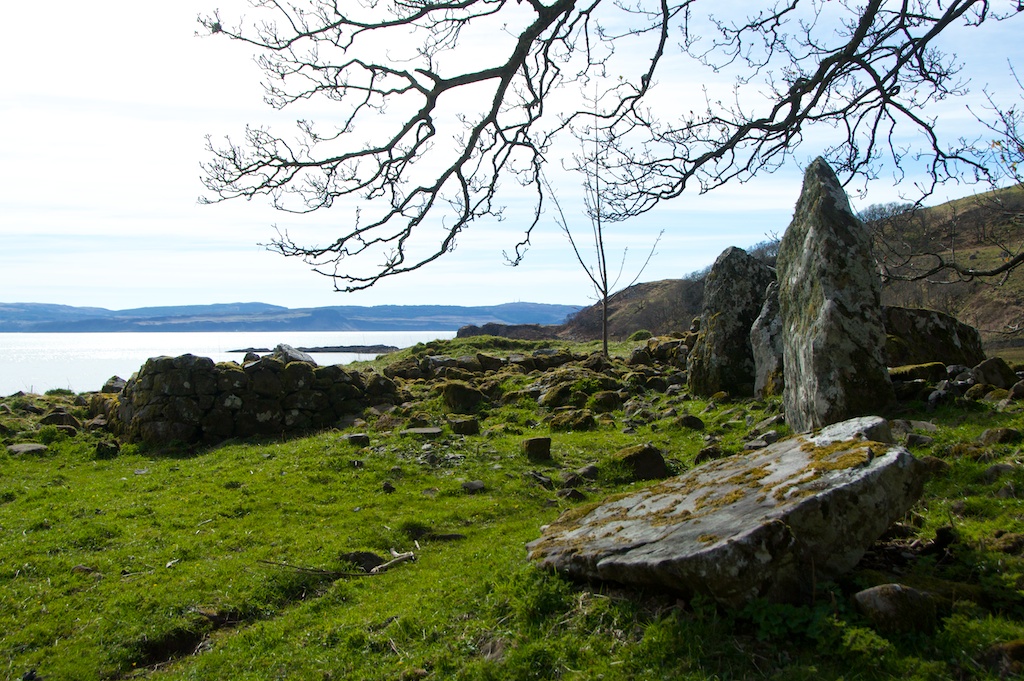

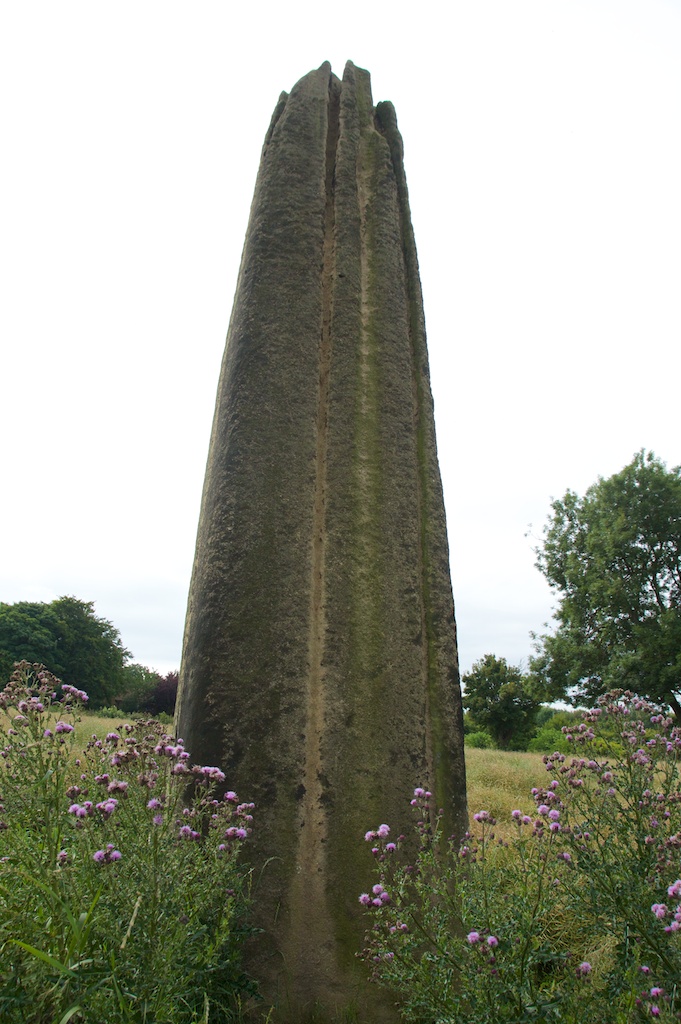
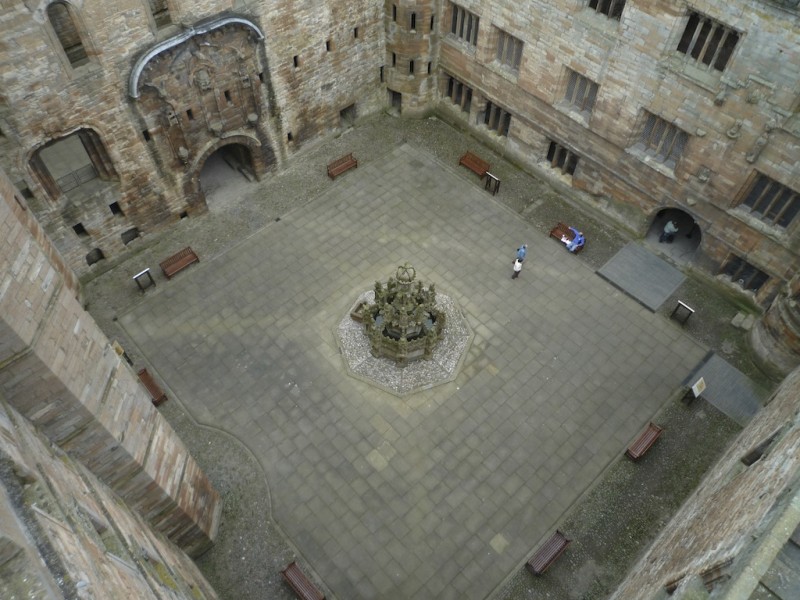
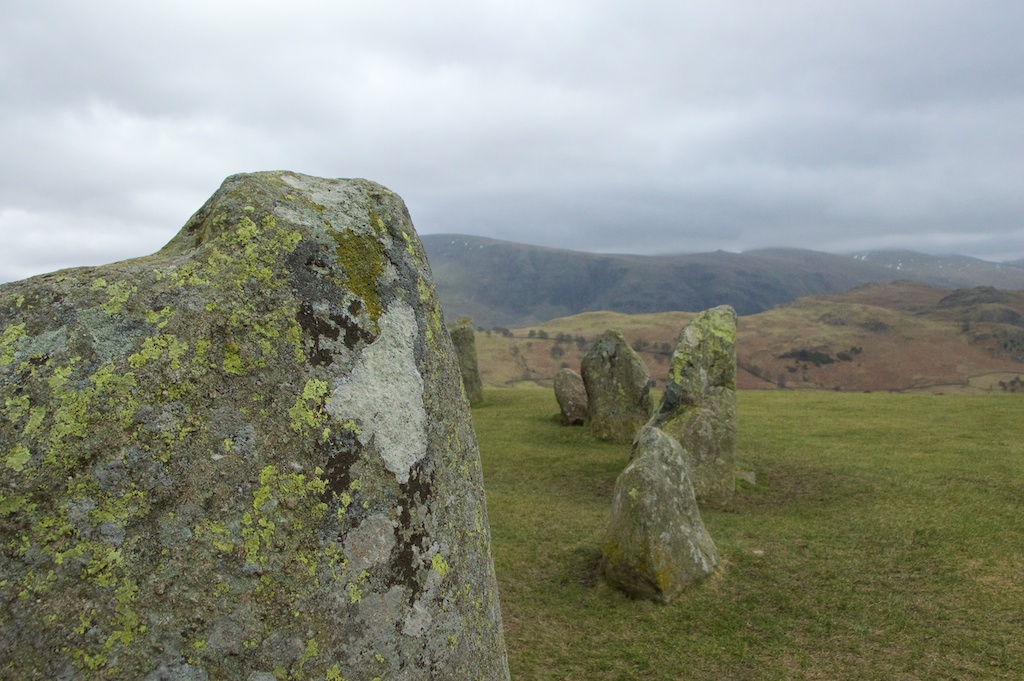
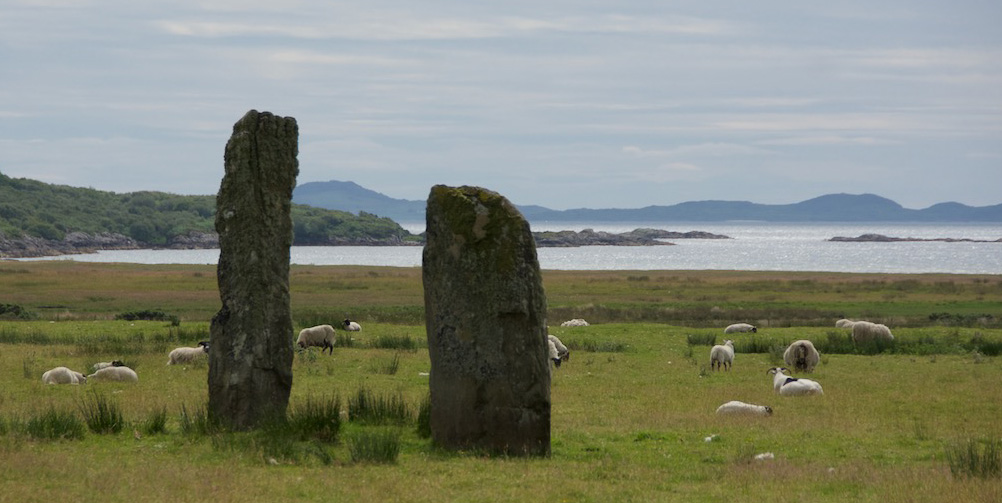
24 Comments
justbod
Another lovely article – one of my favourite sites, and one of the first I ever visited. As you say, the stones are awe-inspiring to visit, even if seen in photos before. The grooves are extremely interesting and thought provoking. Love your discovery of the photo on Wikimedia – I hadn’t come across that before. I hope you do get to visit in the winter months. They are completely different then.
Jo Woolf
Thank you very much, Justbod! Yes, I really didn’t expect anything quite so massive. I would love to see them again in frost or snow. Another for my winter list!
david
Goodness what an amazing height! I’m trying to imagine the effort involved to set it in place.
Jo Woolf
I know – they are incredible! Like petrified monsters.
ordinarygood
What a fascinating post and a fascinating adventure you and Verity went on.
Jo Woolf
Thank you, Lyn! Yes, we enjoyed ourselves very much!
Pat
What an incredible sight those are! There’s some ancient engineering going on here. They needed to be sunk into the soil so they would stay upright and placed on the clay so they wouldn’t sink. These people knew what they were doing. Can’t be worshiping stones that keep falling over.
Jo Woolf
They certainly did know what they were doing, Pat! And yes, you’re right – you wouldn’t want one wobbling over and squashing the archdruid or something!
tearoomdelights
How bizarre, I’ve never seen standing stones as tall as that, not to mention grooved in that mysterious manner. I particularly like the one lurking in the undergrowth watching you silently, it’s quite spooky. I’m sorry to hear about your dowsing rods but I think I would enjoy reading your Disastrous Dowsing blog.
Jo Woolf
I know, they are so amazing and I am certainly not convinced the grooves are natural. Yes, the one in the trees had a very strong presence! Haha, don’t tempt me about the blog!
tearoomdelights
Go on, start the blog. It’ll make me feel less ridiculous about mine if you have another blog, too.
Jo Woolf
Haha, LOL! That made me laugh!
That made me laugh!
tomog2015
Nice pics never seen these stones before definite worth a visit.
My Dowsing powers detect a spare Telescopic Rod like yours in my house
You can try some Deviceless Dowsing to find it and its yours.
It either in its pouch on the coffee table or beside my P.C table ? No Pressure on this test by the way !
Jo Woolf
Haha, Tom, you have such faith in my ability! That made me laugh this morning! I would say it’s on the coffee table. But actually Colin managed to mend the rod, thankfully, and they both survived another outing yesterday, to Jedburgh and Dryburgh Abbeys without any mishap! Thank you for the kind offer though. That reminds me that I can try to locate stuff in the house, which is a good practice when it’s tipping with rain!
That made me laugh this morning! I would say it’s on the coffee table. But actually Colin managed to mend the rod, thankfully, and they both survived another outing yesterday, to Jedburgh and Dryburgh Abbeys without any mishap! Thank you for the kind offer though. That reminds me that I can try to locate stuff in the house, which is a good practice when it’s tipping with rain!
tomog2015
Will keep a hold of it just in case Happy Dowsing !
Jo Woolf
Thanks, Tom!
McEff
I lived within a few miles of those stones for nearly twenty years and never visited them once. That was obviously a mistake because they are seriously impressive. And they certainly look carved to me, because you don’t see tall, smooth stones with grooves like those carved in them in natural situations.
Regards, Alen
Jo Woolf
Verity and Chris live quite close (Leeds) and had never heard of them! I agree absolutely that they look carved, although for what purpose is a real mystery. Thanks, Alen!
blosslyn
Wow, they are amazing, need to visit one day, great photos, just amazing how they are still standing
Jo Woolf
I know, Lynne, I won’t forget them for a long time, that’s for sure!
hamertheframer
I remember seeing one of these from the coach on my way up to Newcastle many years ago. I hadn’t realised there are three of them. Great to see them up close.
Jo Woolf
Easily done, and I think you would definitely need to know where to look! The third one is hard to see unless you are really looking for it, and the smaller (shorter) one is half-hidden in trees. They are extraordinary viewed up close – well worth stopping next time you’re passing.
Sandra Longfield
I visited yesterday while on a food shopping trip to Boroughbridge. .We got out if the car near the big black woodland arrow and like you after gazing up at it and standing close to it I felt a heavy energy and slightly woozy feeling.
Love your descriptions and visitor post x love Sandra
Jo Woolf
Hi Sandra, that’s so interesting! Thank you for sharing that! There must be a really strong energy about that stone. It’s fascinating how we respond to these places – I want to do some more dowsing this year, in similar sites around here in Argyll. Thanks again, and I’m really glad you enjoyed the post. With best wishes, Jo